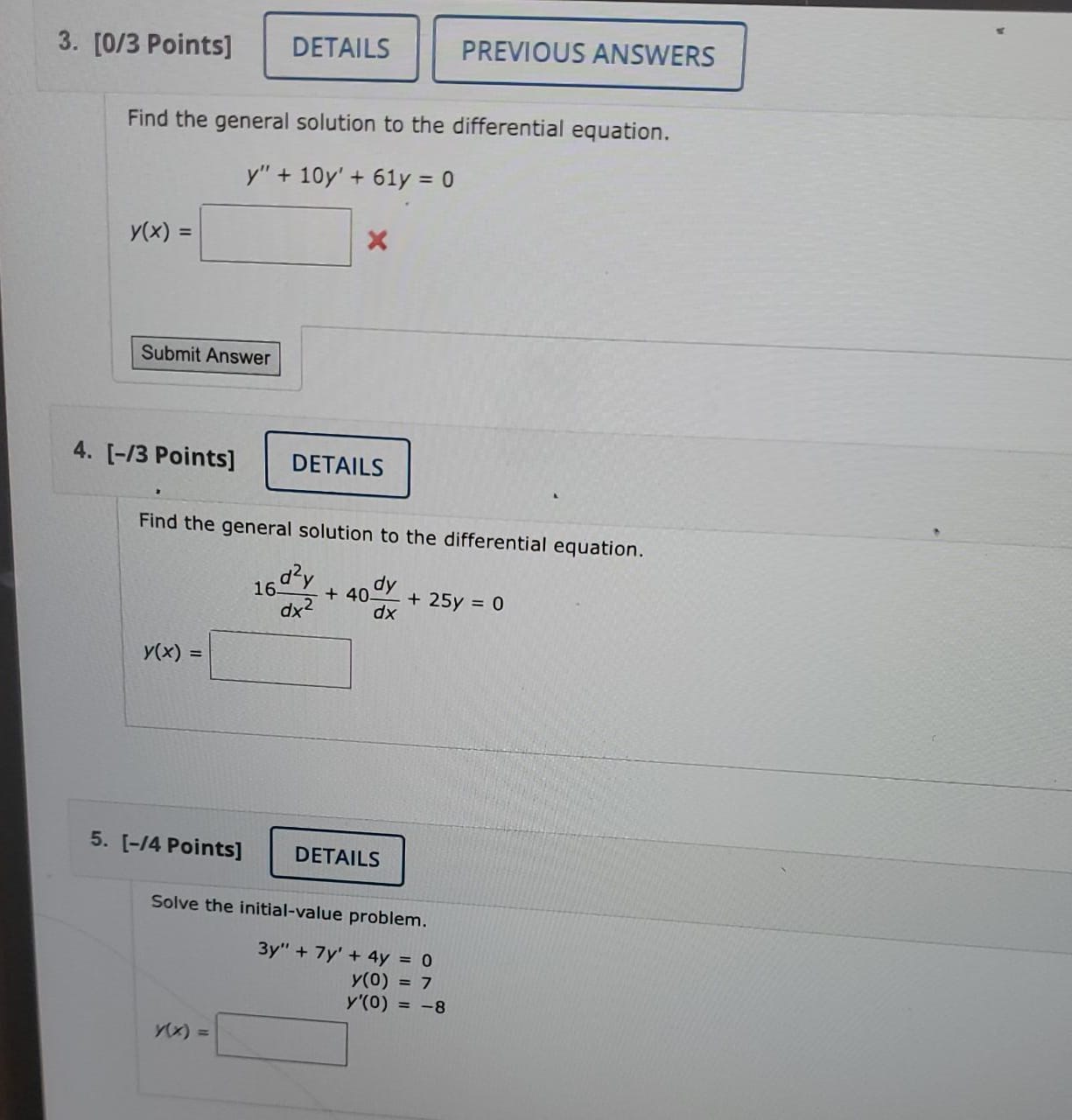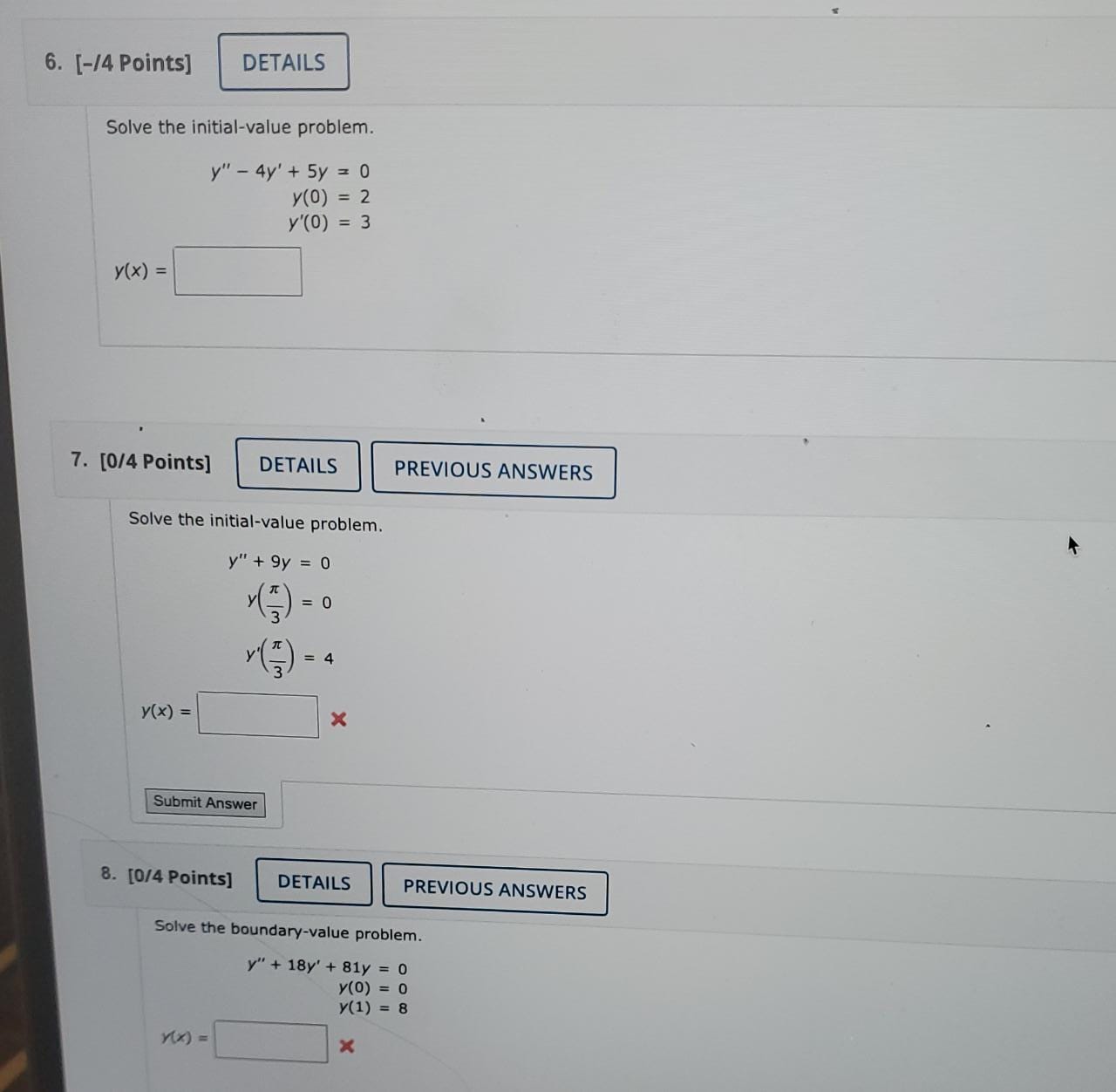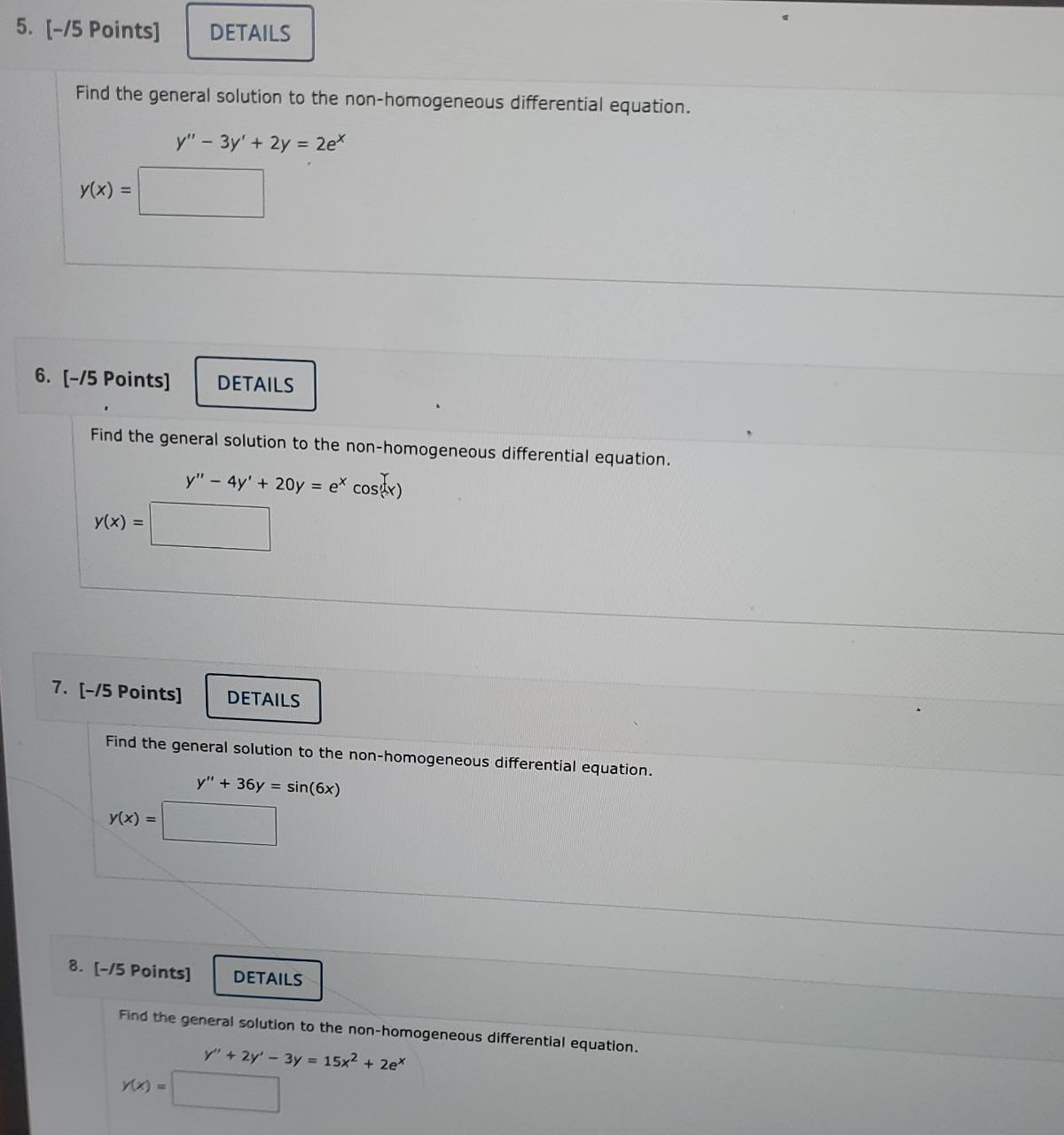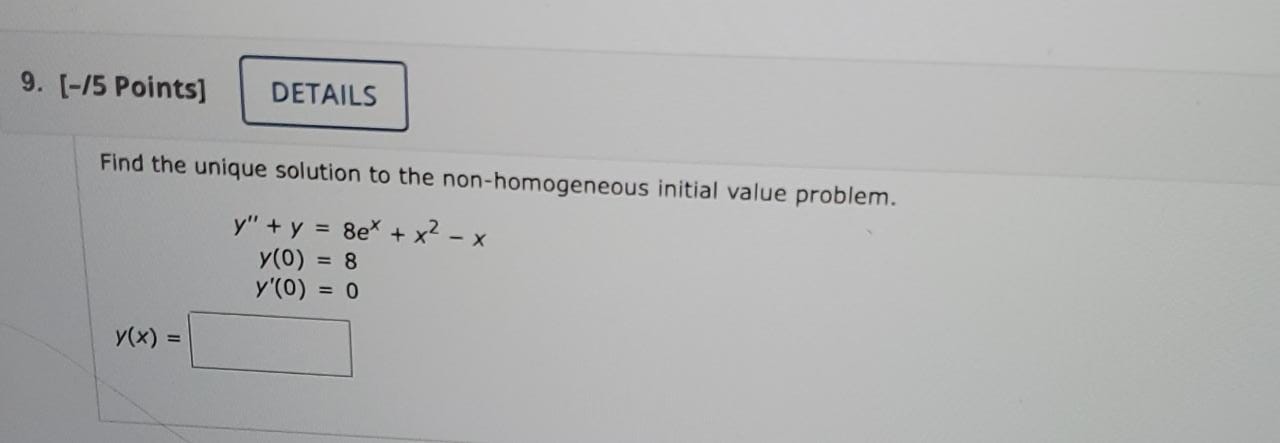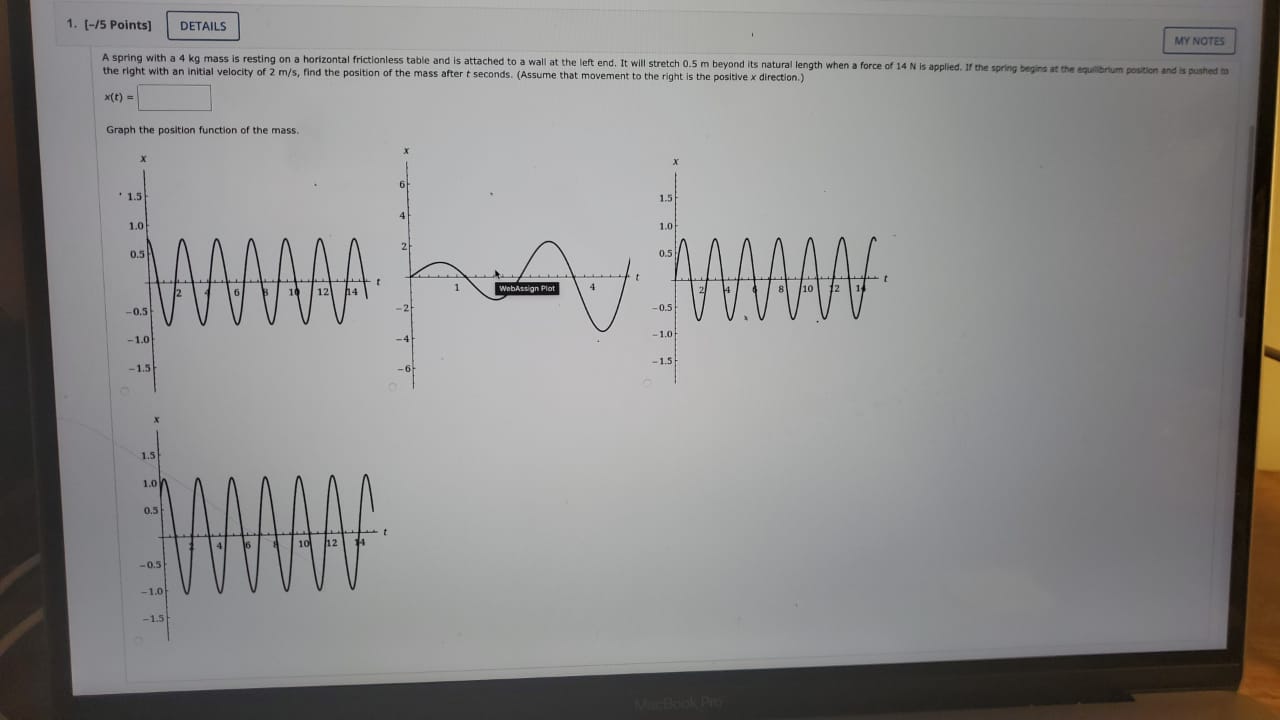Can you help me with these questions? it's ok if you do only some of them.
3. [0/3 Points] DETAILS PREVIOUS ANSWERS Find the general solution to the differential equation. y" + 10y' + 61y = 0 Y ( x ) = X Submit Answer 4. [-/3 Points] DETAILS Find the general solution to the differential equation. 16 day + 40-+ 25y = 0 dx 2 dx y ( x ) = 5. [-/4 Points] DETAILS Solve the initial-value problem. 3y" + 7y' + 4y = 0 y(0) = 7 y'(0 ) = -8 Y ( x ) =6. [-/4 Points] DETAILS Solve the initial-value problem. y" - 4y' + 5y = 0 y (0 ) = 2 y' (0 ) = 3 y ( x ) = 7. [0/4 Points] DETAILS PREVIOUS ANSWERS Solve the initial-value problem. y" + 9y = 0 y ( 5) = 0 " ( ) = y ( x ) = X Submit Answer 8. [0/4 Points] DETAILS PREVIOUS ANSWERS Solve the boundary-value problem. y" + 18y' + 81y = 0 y(0) = 0 y(1) = 8 x x) = X1. [-/5 Points] DETAILS Find the general solution to the non-homogeneous differential equation. y" + 5 y' + 4y = 3x2 y ( x ) = 2. [-/5 Points] DETAILS Find the general solution to the non-homogeneous differential equation. y" - 3y' = sin(3x) y ( x ) = 3. [-/5 Points] DETAILS Find the general solution to the non-homogeneous differential equation. y" - 4y' + 5y = 4e-* Y ( x ) = 4. [-/5 Points] DETAILS Find the general solution to the non-homogeneous differential equation. y" - 2y' - 15y = xe3x * ( ) =5. [-/5 Points] DETAILS Find the general solution to the non-homogeneous differential equation. y " - 3y' + 2y = ze* y ( x ) = 6. [-/5 Points] DETAILS Find the general solution to the non-homogeneous differential equation. y" - 4y' + 20y = ex cosix) y ( x ) = 7. [-/5 Points] DETAILS Find the general solution to the non-homogeneous differential equation. y" + 36y = sin(6x) y ( x ) = 8. [-/5 Points] DETAILS Find the general solution to the non-homogeneous differential equation. y' + 2y' - 3y = 15x2+ 2ex9. [-/5 Points] DETAILS Find the unique solution to the non-homogeneous initial value problem. y " + y = 8 e* + x2 - x y(0) = 8 y' (0 ) = 0 y (x ) =1. [-/5 Points] DETAILS A spring with a 4 kg mass is resting on a horizontal frictionless table and is attached to a wall at the left end. It will stretch 0.5 m beyond its natural length when a force of 14 N is applied, If the spring begins at the equilibrium position and is pushed to the right with an Initial velocity of 2 m/'s, find the position of the mass after t seconds. (Assume that movement to the right is the positive x direction.) MY NOTES * (t ) = Graph the position function of the mass. * 1.5 1.0 4 1.5 1.0 2 05 -0.5 HAAAAAA . WebAssign Plat -2 -0.5 AAAAAAS -1.0 -4 -1.0 -1.5 -1.5 1.5 1.0 0.3 -0.5 -1.0 -1.52. [-/5 Points] DETAILS MY NOTES A spring with a mass of 2 kg has a damping constant 14 kg/s. A force of 3.6 N is required to keep the spring stretched 0.3 m beyond its natural length. The spring is stretched 0.7 m beyond its natural length and then released, Find the position of the mass at any time t. (Assume that movement to the right is the positive x-direction and the spring is attached to a wall at the left end.) x (f ) = 3. [-/5 Points] DETAILS MY NOTES A spring with a mass of 2 kg has a damping constant 14 kg/s. A force of 3.6 N is required to keep the spring stretched 0.3 m beyond its natural length. The spring is stretched 0.8 m beyond its natural length and then released If an external force of F (t) = 10e N is applied to the spring, find the position of the mass at any time.t. x(t) = 4. [-/5 Points] DETAILS MY NOTES A spring with a mass of 1 kg has a spring constant 43 kg/s . If the spring begins at equilibrium position and is given a velocity of 3 m/s, find the damping constant that would produce critical damping MY NOTES 5. [-/8 Points] DETAILS A series circuit consists of a resistor with R = 20 0, an inductor with L = 1 H, a capacitor with C = 0.01 F, and a 11-volt battery, If the initial charge and current are Initially both @, find the charge and current at tine charge Q(t) =5. [-/8 Points] DETAILS MY NOTES A series circuit consists of a resistor with R = 20 0, an inductor with _ = 1 H, a capacitor with C = 0.01 F, and a 11-volt battery. If the Initial charge and current are initially both 0, find the charge and current at time t. charge Q(t) - current 1(t ) = 6. [0/8 Points] DETAILS PREVIOUS ANSWERS MY NOTES time t. A series circuit consists of a resistor with R = 20 0, an inductor with 2 = 1 H, a capacitor with C = 0.01 F. and a generator producing a voltage of E(t) = 160 sin(10:). If the initial charge and current are initially both 0, find the charge and currant at charge Q (t ) = current I(t ) = Submit Answer MY NOTES 7. [-/5 Points] DETAILS A series circuit consists of a resistor with R = 20 0, a capacitor with C - 0.01 F, and a decaying battery with F = 500e . If the initial charge is 0, find the charge as a function of time to Submit Assignment Save Assignment Progress Home My Assignments
